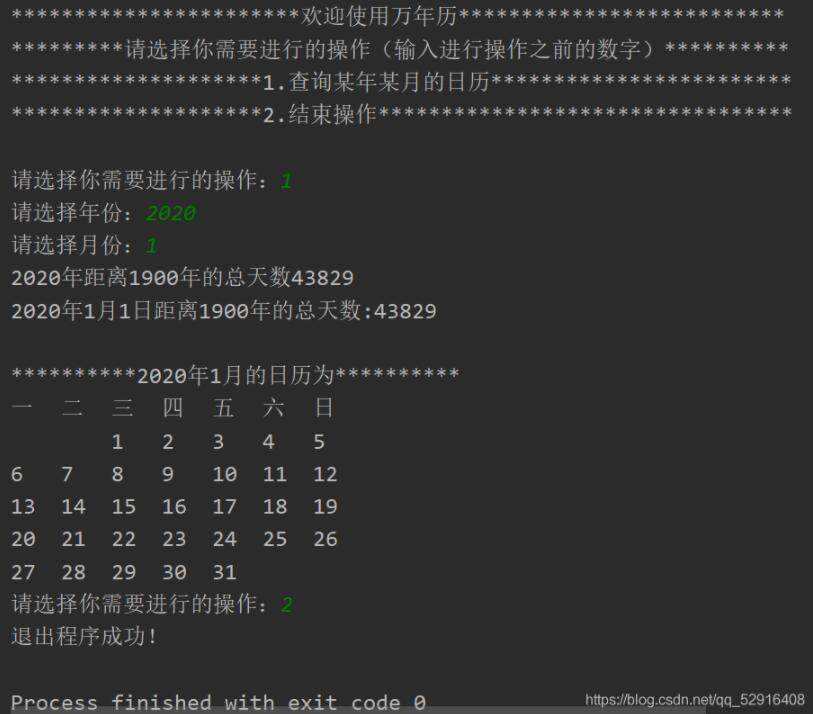本文實(shí)例為大家分享了Java實(shí)現(xiàn)簡(jiǎn)單萬(wàn)年歷的具體代碼,供大家參考,具體內(nèi)容如下
1 要求
1、輸入年份;
2、輸入月份;
3、輸出某年某月的日歷。
2 思路
1、實(shí)現(xiàn)從控制臺(tái)接收年和月,判斷是否是閏年(判斷是否是閏年:能被4整除但不能被100整除;或者能被400整除);
2、計(jì)算輸入月份的天數(shù);
3、計(jì)算該月第一天是星期幾;
3.1 計(jì)算輸入年份距離1900年1月1日的天數(shù);
3.2 計(jì)算輸入月份之前的天數(shù)(從當(dāng)年年初開(kāi)始);
3.3 將以上兩組數(shù)據(jù)進(jìn)行求和;
3.4 已知該月之前的天數(shù),計(jì)算輸入月份的第一天是星期幾(從1900年1月1日(星期一)開(kāi)始推算: 星期幾 = 1 + 天數(shù)差 % 7 )。
4、按格式輸出該月日歷 。
3 源代碼
|
1
2
3
4
5
6
7
8
9
10
11
12
13
14
15
16
17
18
19
20
21
22
23
24
25
26
27
28
29
30
31
32
33
34
35
36
37
38
39
40
41
42
43
44
45
46
47
48
49
50
51
52
53
54
55
56
57
58
59
60
61
62
63
64
65
66
67
68
69
70
71
72
73
74
75
76
77
78
79
80
81
82
83
84
85
86
87
88
89
90
91
92
93
94
95
96
97
|
import java.util.Scanner;public class index { //每個(gè)月的天數(shù) public static int monthday(int month, int year) { if ((year % 4 == 0 && year % 100 != 0) || year % 400 == 0) { int[] day = {0, 31, 29, 31, 30, 31, 30, 31, 31, 30, 31, 30, 31}; return day[month]; } else { int[] day = {0, 31, 28, 31, 30, 31, 30, 31, 31, 30, 31, 30, 31}; return day[month]; } } //月份總天數(shù) public static int monthdays(int month, int year) { int totaldays = 0; for (int i = 1; i < month; i++) { totaldays = totaldays + monthday(i, year); } return totaldays; } //距離1900年的年份總天數(shù) public static int yeardays(int year){ int yeardays = 0; for (int i = 1900;i<year;i++){ if ((i % 4 == 0 && i % 100 != 0) || i % 400 == 0) { yeardays = yeardays+366; } else { yeardays = yeardays+365; } } System.out.println(year+"年距離1900年的總天數(shù)"+yeardays); return yeardays; } //輸出日歷 public static void printCalendar(int month,int year){ int totaldays = 0; if (year > 0) { if (month > 0 && month < 13) { //距離1900年1月1日總天數(shù) totaldays = monthdays(month,year)+yeardays(year); System.out.println(year+"年"+month+"月1日距離1900年的總天數(shù):"+totaldays); System.out.println("\n**********"+year+"年"+month+"月的日歷為**********"); System.out.println("一\t二\t三\t四\t五\t六\t日\(chéng)t"); int week = 1+totaldays%7; //根據(jù)1日為周幾輸出空格 for(int i=1;i<week;i++){ System.out.print(" \t"); } //輸入具體日期 for(int i=1;i<=monthday(month,year);i++){ System.out.print(i+"\t"); if(week==7){ week = 1;//重置為星期一 System.out.println(); }else{ week++; } } } else { System.out.println("輸入的月份不合法!"); } } else { System.out.println("輸入的年份不合法!"); } } //主函數(shù) public static void main(String[] args) { Scanner scanner = new Scanner(System.in); System.out.println("***********************歡迎使用萬(wàn)年歷**************************"); System.out.println("*********請(qǐng)選擇你需要進(jìn)行的操作(輸入進(jìn)行操作之前的數(shù)字)**********"); System.out.println("********************1.查詢某年某月的日歷************************"); System.out.println("********************2.結(jié)束操作*********************************"); System.out.print("\n請(qǐng)選擇你需要進(jìn)行的操作:"); int a = scanner.nextInt(); for (int i=0;i>=0;i++) { switch (a) { case 1: System.out.print("請(qǐng)選擇年份:"); int year = scanner.nextInt(); System.out.print("請(qǐng)選擇月份:"); int month = scanner.nextInt(); printCalendar(month, year); System.out.print("\n請(qǐng)選擇你需要進(jìn)行的操作:"); a = scanner.nextInt(); break; case 2: System.out.println("退出程序成功!"); return; } } }} |
4 結(jié)果截圖

注意:我的周日是在最后一欄
以上就是本文的全部?jī)?nèi)容,希望對(duì)大家的學(xué)習(xí)有所幫助,也希望大家多多支持服務(wù)器之家。
原文鏈接:https://blog.csdn.net/qq_52916408/article/details/115820910













